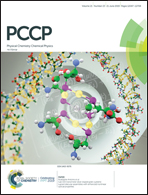The performance of adsorption, dissociation and diffusion mechanism of hydrogen on the Ti-doped ZrCo(110) surface†
Abstract
Compared with pristine ZrCo(110), the adsorption, dissociation, and successive diffusion of hydrogen on the Ti-decorated ZrCo(110) have been investigated based on first-principles calculation. For the purpose of having fast absorption kinetics, both activation processes need to overcome small energy barriers. The adsorption energies of molecular as well as atomic hydrogen on the Ti-decorated ZrCo(110) surface were calculated using first-principles calculations with the periodic density functional theory (DFT). The H2 molecule on ZrCo(110) and Ti-doped ZrCo(110) surfaces could be spontaneously partially dissociated due to the interaction with the substrate surfaces, producing H atoms strongly chemisorbed to the hollow sites. The H2 dissociation energy barrier and the H diffusion barrier were also determined. Our results show that the activation energy for H2 dissociation on the decorated surface (0.052 eV) is much smaller than that of the pure surface (0.524 eV), elucidating that the activation condition of H2 on the pure ZrCo(110) is more severe than that on the Ti-doped surface. Particularly, Ti-decoration facilitates the H2 dissociation. Moreover, the re-desorption performance of the two dissociated H atoms is improved by lowering the energetic barrier from 1.798 eV (on the pure surface) to 1.315 eV (on the decorated surface). The calculations also reveal that decorating the surface with Ti eliminates the barrier for the into-bulk penetration of a hydrogen atom. Based on the local density of states, the Bader charge and differential charge density, as well as the influence of the Ti atom on topological properties were analyzed. Theoretical results presented in this study are generally in well accordance with the available theoretical and experimental data.



 Please wait while we load your content...
Please wait while we load your content...